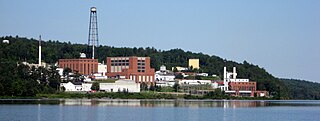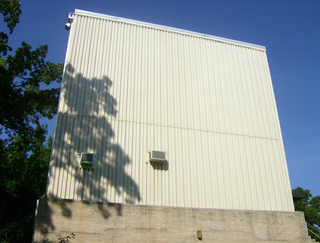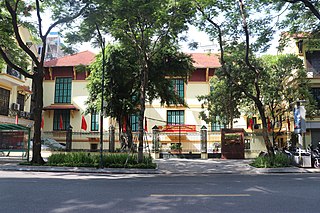
A nuclear reactor is a device used to initiate and control a fission nuclear chain reaction. Nuclear reactors are used at nuclear power plants for electricity generation and in nuclear marine propulsion. When a fissile nucleus like uranium-235 or plutonium-239 absorbs a neutron, it splits into lighter nuclei, releasing energy, gamma radiation, and free neutrons, which can induce further fission in a self-sustaining chain reaction. The process is carefully controlled using control rods and neutron moderators to regulate the number of neutrons that continue the reaction, ensuring the reactor operates safely. The efficiency of energy conversion in nuclear reactors is significantly higher compared to conventional fossil fuel plants; a kilo of uranium-235 can release millions of times more energy than a kilo of coal.

Chalk River Laboratories is a Canadian nuclear research facility in Deep River, about 180 km (110 mi) north-west of Ottawa.
Atomic Energy of Canada Limited (AECL) is a Canadian federal Crown corporation and Canada's largest nuclear science and technology laboratory. AECL developed the CANDU reactor technology starting in the 1950s, and in October 2011 licensed this technology to Candu Energy.

Forschungszentrum Jülich (FZJ) is a German national research institution that pursues interdisciplinary research in the fields of energy, information, and bioeconomy. It operates a broad range of research infrastructures like supercomputers, an atmospheric simulation chamber, electron microscopes, a particle accelerator, cleanrooms for nanotechnology, among other things. Current research priorities include the structural change in the Rhineland lignite-mining region, hydrogen, and quantum technologies. As a member of the Helmholtz Association with roughly 6,800 employees in ten institutes and 80 subinstitutes, Jülich is one of the largest research institutions in Europe.

The Bhabha Atomic Research Centre (BARC) is India's premier nuclear research facility, headquartered in Trombay, Mumbai, Maharashtra, India. It was founded by Homi Jehangir Bhabha as the Atomic Energy Establishment, Trombay (AEET) in January 1954 as a multidisciplinary research program essential for India's nuclear program. It operates under the Department of Atomic Energy (DAE), which is directly overseen by the Prime Minister of India.
The Australian Nuclear Science and Technology Organisation is a statutory authority of the Australian Government that is charged with conducting nuclear research, and with the production of radioisotopes for nuclear medicine. It was established in 1987 to replace the prior Australian Atomic Energy Commission (AAEC), formed in 1952.

Research reactors are nuclear fission-based nuclear reactors that serve primarily as a neutron source. They are also called non-power reactors, in contrast to power reactors that are used for electricity production, heat generation, or maritime propulsion.
The National Research Universal (NRU) reactor was a 135 MW nuclear research reactor built in the Chalk River Laboratories, Ontario, one of Canada’s national science facilities. It was a multipurpose science facility that served three main roles. It generated radionuclides used to treat or diagnose over 20 million people in 80 countries every year. It was the neutron source for the NRC Canadian Neutron Beam Centre: a materials research centre that grew from the Nobel Prize-winning work of Bertram Brockhouse. It was the test bed for Atomic Energy of Canada Limited to develop fuels and materials for the CANDU reactor. At the time of its retirement on March 31, 2018, it was the world's oldest operating nuclear reactor.

The SLOWPOKE is a family of low-energy, tank-in-pool type nuclear research reactors designed by Atomic Energy of Canada Limited (AECL) beginning in the late 1960s. John W. Hilborn is the scientist most closely associated with their design. They are beryllium-reflected with a very low critical mass, but provide neutron fluxes higher than available from a small particle accelerator or other radioactive sources.
Generation IVreactors are nuclear reactor design technologies that are envisioned as successors of generation III reactors. The Generation IV International Forum (GIF) – an international organization that coordinates the development of generation IV reactors – specifically selected six reactor technologies as candidates for generation IV reactors. The designs target improved safety, sustainability, efficiency, and cost. The World Nuclear Association in 2015 suggested that some might enter commercial operation before 2030.

North Carolina State University in 1950 founded the first university-based reactor program and Nuclear Engineering curriculum in the United States. The program continues in the early 21st century. That year, NC State College administrators approved construction of a reactor and the establishment of a collegiate nuclear engineering program. The first research reactor was completed in 1953; it was scaled up in 1957 and 1960. It was deactivated in 1973 to make way for the PULSTAR reactor. The old reactor has been decommissioned.
The Korea Atomic Energy Research Institute (KAERI) in Daejeon, South Korea was established in 1959 as the sole professional research-oriented institute for nuclear power in South Korea, and has rapidly built a reputation for research and development in various fields.

The Oregon State University Radiation Center (OSURC) is a research facility that houses a nuclear reactor at Oregon State University (OSU) in Corvallis, Oregon, United States. The Oregon State TRIGA Reactor (OSTR) serves the research needs of the OSU nuclear engineering department along with other departments.

The MIT Nuclear Research Reactor (MITR) serves the research purposes of the Massachusetts Institute of Technology. It is a tank-type 6 megawatt reactor that is moderated and cooled by light water and uses heavy water as a reflector. It is the second largest university-based research reactor in the U.S. and has been in operation since 1958. It is the fourth-oldest operating reactor in the country.

Iran's nuclear program is made up of a number of nuclear facilities, including nuclear reactors and various nuclear fuel cycle facilities.

The Missouri University of Science and Technology Nuclear Reactor is a swimming pool type nuclear reactor operated by the Missouri University of Science and Technology. It first achieved criticality in 1961, making it the first operational nuclear reactor in the state of Missouri. Missouri S&T operates this reactor for training, education, and research purposes.

Jordan Atomic Energy Commission (JAEC) was established in place of the Jordan Nuclear Energy Commission. The main objective of the JAEC is to promote and develop peaceful utilization of atomic energy.
In December 2016, the Jordan Atomic Energy Commission (JAEC), in cooperation with a consortium headed by the Korean Atomic Energy Research Institute, inaugurated the 5 MW Jordan Research and Training Reactor. The facility is the first nuclear reactor in the country. It will provide radioactive isotopes for medical usage in Jordan, and will provide training for students at the University to produce a skilled workforce for the country's planned commercial nuclear reactors.

13/9/1993: National Atomic Energy Commission was renamed Vietnam Atomic Energy Institute under the Ministry of Science, Technology and Environment (According to Decree No. 59/CP dated September 13, 1993 of the Government)
Science and technology is Jordan's growing economic sector. This growth is occurring across multiple industries, including information and communications technology (ICT), solar and wind energy and nuclear technology.













